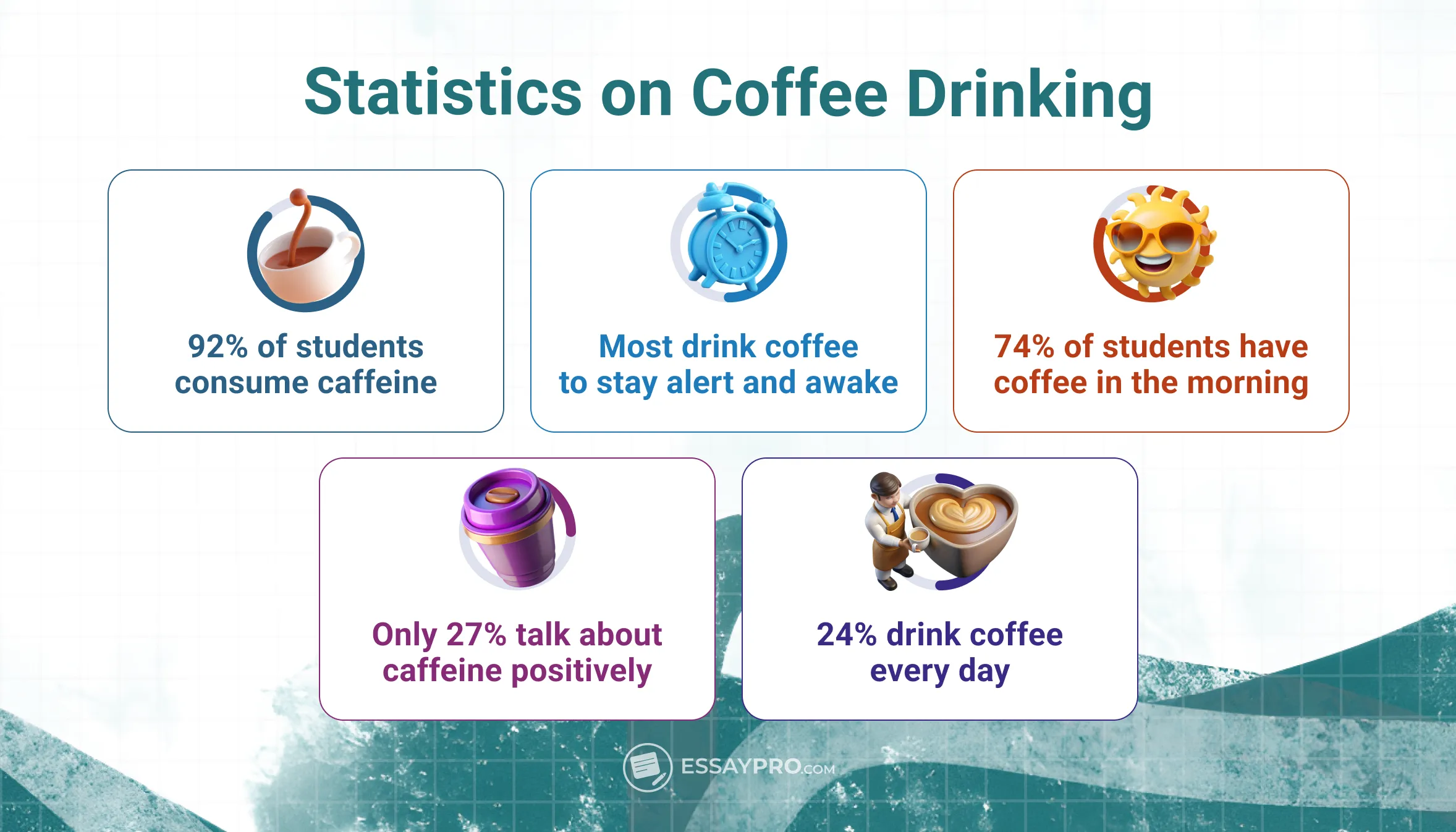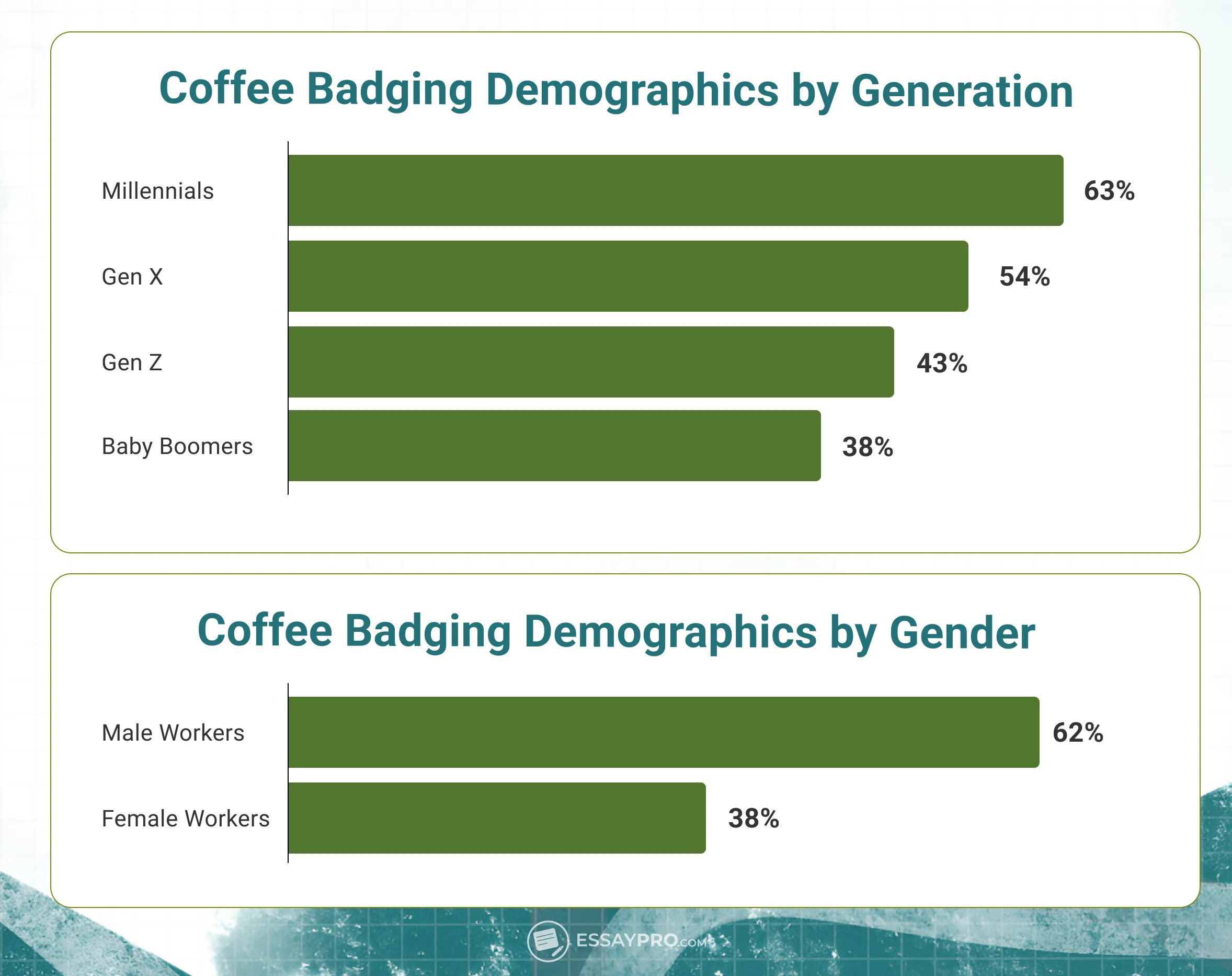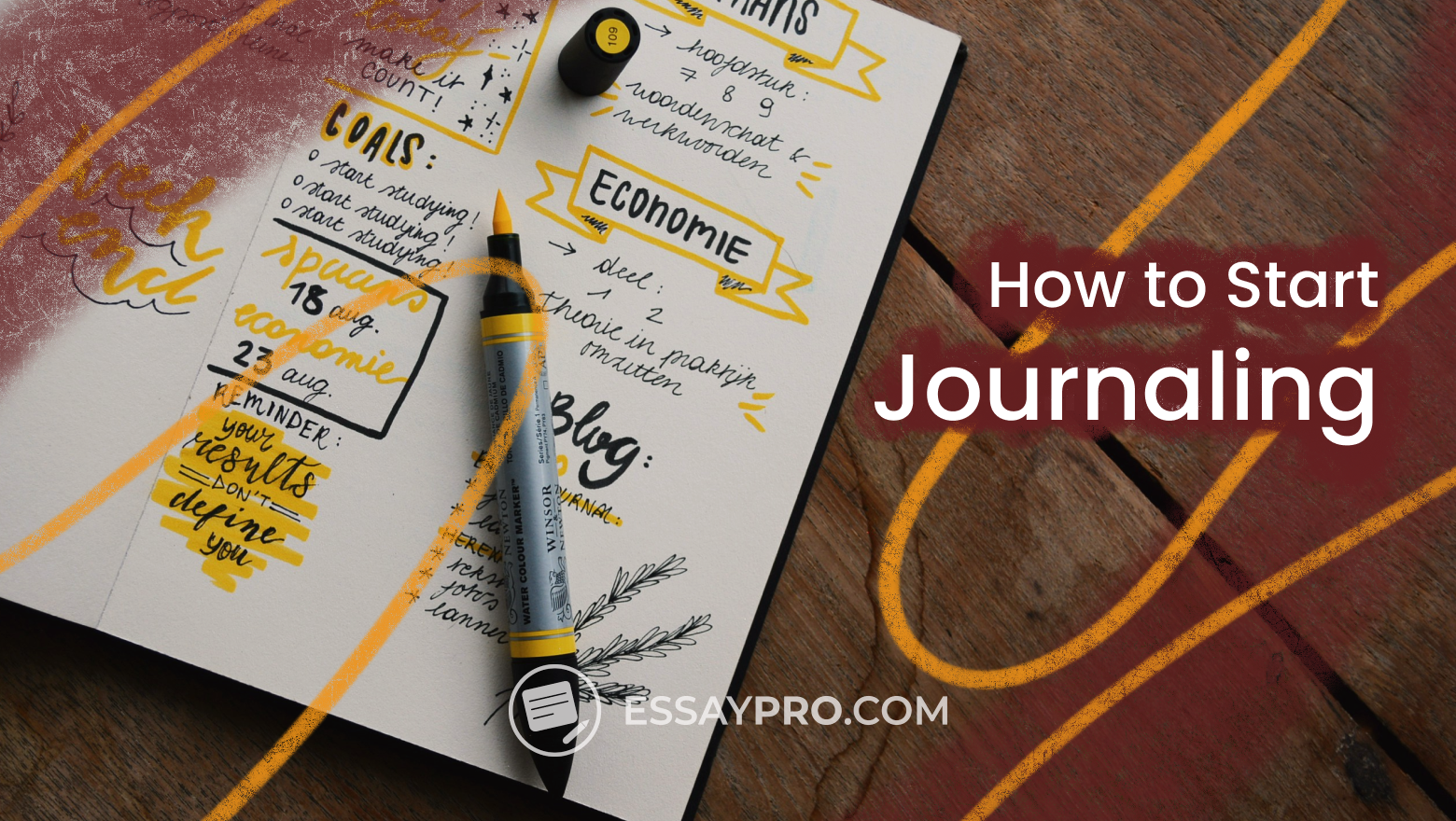It starts with a quick hello, a coffee in hand, and a few minutes at your desk. Then you’re out the door before your inbox even loads. It's called coffee badging, which, for some, is a clever way to stay visible without committing to a full day of work. For the teams trying to collaborate, though, something as simple as a coffee at work can chip away at consistency and productivity. So, how does accountability shift when no one’s keeping track of how long you stay?
If you're a student writing about a modern workplace trend or simply want to learn how hybrid work changed the entire company culture, this article will help you make sense of the numbers.
And if you need help turning your notes into something polished and well-structured, EssayPro's expert academic writing support is always a few clicks away.
What the Numbers Say About Coffee Habits
It's been a long time since coffee was just a morning habit. For students, it's often exactly what gets them through study sessions and early classes. At work, on the other hand, a coffee cup sometimes acts like a pass: it says that you're already here, even if the workday hasn't started yet. In short, caffeine is already a part of the culture. Here's what coffee habits look like in numbers:

- 92% of students use caffeine, mostly to stay focused or alert.
- The most common reason for drinking it is to feel awake.
- 74% drink coffee in the morning, often before class or work.
- Only 27% think coffee is a positive substance, which shows the growing concerns around health.
- 24% drink coffee every day, treating it more as a routine than a choice.
Coffee might still feel like a productivity tool. But the story can change when showing up becomes more about being seen than actually contributing.
What Is Coffee Badging?
Coffee badging is when someone drops by the office just long enough to swipe their badge, pour a coffee, chat for a minute, then head out. They might finish the day working from home, or they might not do much work at all. It's subtle, but it's also growing.
Between 2022 and 2024, about 50% to 53% of workers were in hybrid roles. As the new work schedules became the norm, the flexibility that came with it allowed employees to create new routines. Some are truly productive. Others, like having coffee at work, might just be keeping up appearances: people started showing up not to work in the office, but to prove they’d been there.

A quick visit with a coffee in hand might seem harmless, but over time, those small trips start to matter: it changes who’s visible. It shapes who managers trust. It shifts who ends up doing most of the real work.


Who’s Actually Coffee Badging?
Coffee badging isn’t just something a few people quietly do on the side. It’s actually pretty common, and it depends on several different factors: age, gender, and how someone generally handles the pressure. Right now, 58% of hybrid employees are coffee badgers. Another 8% haven’t tried it yet, but they’re thinking about it. Coffee badging is also especially popular among millennials:

- Among hybrid workers, 63% of Millennials coffee badge.
- That drops slightly to 54% for Gen X, 43% for Gen Z, and 38% for Boomers.
- It’s also more common among men: 62% of male employees report doing it, compared to 38% of women.
So, we can clearly see that coffee badging is not necessarily tied to one kind of person or job. Some people see it as a way to still follow the rules without "sacrificing" too much of their day, and based on numbers, they're anything but alone.
What’s Fueling the Coffee Badging Trend
The coffee badging trend started to emerge because hybrid work blurred the lines between "in the office" and "working." When the rules aren't exactly clear about how many days employees should be there, many settle for showing up just long enough to be seen. To break down what’s really driving this shift:

- Rising office expenses: A typical office day costs around $51. That includes commuting, meals, coffee, parking, and even childcare. When you’re spending that much just to be there, that quick cup-and-run approach starts to make sense.
- Return-to-office policies: Another part of the puzzle is how unclear office policies have become. Some companies say they want people in more often, but they don’t really enforce it. And most employees know no one’s tracking exactly how long they stay. So why stick around if no one’s watching?
- Employees chasing flexibility: People want control over their day. It's as simple as that. Coffee badging becomes a way to say, “I’m meeting expectations without giving up control of my schedule or environment.”
Where Did the Coffee Badging Culture Come From?
Coffee badging appeared as the result of a messy transition into hybrid work. No one really knew how to handle this change, and everyone was figuring things out as they went. Somewhere along the way, grabbing a coffee and leaving started to feel like enough.
Changes After Covid
Hybrid work seemed like the best of both worlds once the offices reopened after the pandemic. You could still get everything done from home, but show up when it mattered. But it didn’t take long for things to get confusing. Some people came in every day, others barely showed up at all. No one really agreed on what going into the office was supposed to mean. That’s where coffee badging started to creep in: it gave people a way to show face without sticking around.
People Aren’t Coming In for the Same Reasons
These days, people aren’t heading into the office just to work. They come in to feel connected or simply to be seen. A few are also just tired of spending all their time at home. It's hard to build a clear rhythm when everyone has a different reason for being there. That disconnect causes confusion and sometimes even frustration.
Trust Gets Shaky
When some teammates show up full-time and others breeze in and out, trust can start to slip. People notice and start wondering who’s really putting in the effort. And when no one’s quite sure what the expectations are, it’s easy for those doubts to grow. Coffee badging feeds into that tension, especially when there’s no real communication around it.
Offices Haven’t Kept Up
A lot of office spaces still feel like they’re stuck in 2019. Empty rows of desks, bland meeting rooms, break areas that no one uses... For many employees, it’s hard to justify the commute when the space doesn’t support how they actually work now. The result is that more people stop by briefly just to grab a coffee and head out.
Sometimes, It’s Just About Connection
Employees don't coffee badge just to skip work. For some people, that is an easy way to feel connected to another person: to catch up with a teammate or just have a real conversation for a minute. In 2023, about 21% of students used dating apps, which proves how people are still looking for connections. That casual office coffee line might serve a similar purpose for some.
The Pros and Cons of Coffee Badging
Like almost everything else in the workplace, coffee badging also has its upsides and drawbacks. It all really depends on how people use it and how it fits into the workplace culture.
Why it works:
- It lets employees check in without giving up the flexibility they value so much.
- It helps people stay visible, which can matter for recognition.
- Those quick visits can lead to casual conversations or helpful run-ins.
- For folks with long commutes or tight budgets, it feels like a smart middle ground.
Where it falls short:
- It can lead to resentment if some team members feel like they’re picking up the slack.
- Real collaboration is harder when people don’t stick around.
- It sends mixed signals: being present physically doesn’t always mean participating.
- Over time, it can blur accountability and make it harder to know who’s really contributing.
What Coffee Badging Says About the Workplace
Coffee badging actually reflects on how employees feel at work and what's missing from a comfortable workplace experience. If you take a careful look, it can reveal a lot about the entire organization.
- People want flexibility but don’t always feel comfortable asking for it. So they show up just enough to avoid questions.
- There’s a gap between what managers expect and what employees need.
- Being seen still feels important, even if the real work is happening somewhere else.
- Trust can feel shaky, especially if no one’s talking openly about what’s okay and what’s not.
- If people don’t want to stick around, it might mean the culture isn’t giving them a reason to.
Keep the Habit or Call it Out?
That quick check-in with coffee in hand might seem like no big deal. But should it be something we accept, or is it worth rethinking?
- If we keep pretending it’s fine, things stay vague and expectations stay blurry.
- If we call it out harshly, we risk losing the flexibility people actually like (and need).
- Ignoring it means nobody talks about why it’s happening, which results in a problem never being solved.
- Being honest about it might actually lead to more realistic ways of working.
Why It Might Be Time to Rethink Coffee Badging
The habit itself isn’t really the problem; it’s what it points to. If people would rather show up for five minutes than engage for the day, that says something about the company they're working for.
- It can wear down trust if some people feel like they’re carrying the weight of others.
- It blurs the line between showing up and contributing. And, much like some interpretations of gen z dating statistics where quick check-ins can replace meaningful connection, this habit favors appearances over substance.
- It doesn’t build a real connection but rather just checks a box.
- It usually means that the messages from the top aren't getting across.
How Can Managers Respond?
Leaders don't need to (and shouldn't, really) ban coffee badging entirely. What managers need to understand is that most people aren't trying to trick them or cheat the system; they're trying to make it work around their routines. This doesn't mean that the leaders shouldn't respond, though.
- Say what you actually expect: Don’t dance around your expectations. If there’s a certain number of days you want people in the office, just say so. If it’s more about being there for team activities, say that too. People can’t follow rules that aren’t clear.
- Ask what’s going on: Instead of guessing, talk to your team. Ask what makes them want to come in (or not). That insight makes it easier to fix what’s not working.
- Give people a reason to stay: If people show up for five minutes and leave, maybe the office isn’t doing much for them. Think about what could make it better.
- Make time for people to connect: A quick hallway chat might not always be enough. Plan little moments where the team can communicate. Doesn’t have to be formal, just real and honest.
- Trust your team: People usually do their best when they feel trusted. If they know they’re not being watched or judged, they’re more likely to stick around and actually care about the work.
Wrapping It All Up
It might look like a quick stop for caffeine, but coffee badging says a lot more about work culture than it seems to. We usually see it when people want to keep their flexibility but aren't exactly sure what's expected of them. Most of the time, though, it's caused by unclear signals and a workplace that doesn't make you want to stick around. Here’s the short version:
- Coffee badging is common and growing.
- It’s more about workplace signals than laziness.
- Left unchecked, it can mess with trust and the entire team culture.
- Leaders can do something about it by being honest, clear, and open to change.'
If you're a student digging into hybrid work and the changes in the workplace trends, and need to make your argument more solid, having a little support can help. EssayPro's academic writers can give you just the right writing guidance so you can turn your big ideas into a paper you'll be proud to submit.
Need To Save Time?
Delegate your tasks to the professionals so you can focus resources on what really matters to you.
FAQ
What Is Coffee Badging?
Coffee badging is when someone stops by the office just long enough to be seen. They usually scan their badge, grab a coffee, maybe say a quick hello, and then head out. For many employees, it's an easy way to check the box of showing up without committing to a full day of work.
Is Coffee Badging Bad?
It depends on how and why it’s happening. On its own, coffee badging isn’t necessarily a problem. But if it becomes the norm, it can lead to trust issues and uneven workloads among employees.

Ana Ratishvili
Ana is a professional literary writer with a Master’s Degree in English literature. Through critical analysis and an understanding of storytelling techniques, she can craft insightful guides on how to write literary analysis essays and their structures so students can improve their writing skills.
- Statista - The Statistics Portal. (2024). Statista. https://www.statista.com/search/?q=hybrid+work&p=1
- U.S. college students dating apps by platform 2023| Statista. (2023). Statista. https://www.statista.com/statistics/1559093/us-college-students-dating-apps-usage-by-platform/







